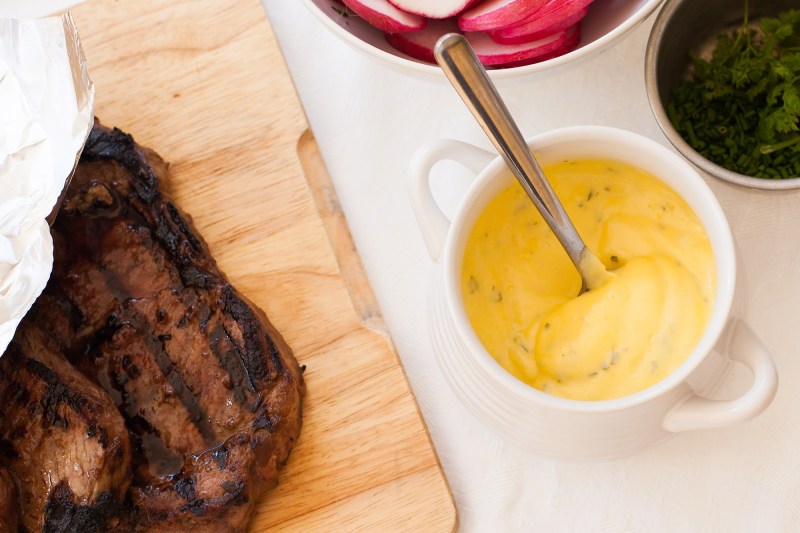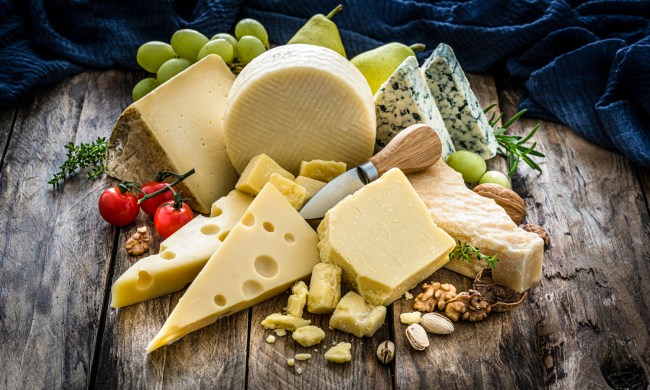
A sauce is added to food for flavor, texture, color, and for moisture. In Classic French cuisine, there are specific techniques and ingredients that make up each sauce. The Five Mother Sauces are your leading sauces or foundation. You can build on the leading sauces to make a secondary leading sauce and from there, small sauces. Each sauce is a variation of the foundation and each with a deeper, more complex flavor.
The sauces that derive from the mother sauces are typically called small sauces but are also known as child sauces. Hollandaise and Bearnaise are essentially the same sauce with a variation in flavorings and they each have their own small sauce.
Related Guides
What is Béarnaise Sauce
Bearnaise sauce is a butter sauce that is emulsified with egg yolks and other flavorings. The sauce was created by accident in 1836 by the chef that invented puffed potatoes. It was named after King Henry IV who was from Béarn.
A Hollandaise Sauce and Bearnaise sauce share the common ingredients of clarified butter and egg yolk. From there, Hollandaise relies on lemon juice for its acid while Bearnaise utilizes white wine and tarragon vinegar, and additional spices.
How to Make Bearnaise Sauce
The basic steps for creating the sauce are by placing the white wine and tarragon vinegar in a small saucepan with chopped shallots, chopped fresh tarragon leaves, chopped chervil, crushed peppercorns, and a pinch of salt. Reduce the liquid and cool. From there, add the yolks to the reduction and place the small saucepan over medium heat and whisk in the clarified butter. Once the egg mixture and butter have been incorporated or emulsified, then pass through a strainer and adjust the seasonings and add a pinch of cayenne and chopped tarragon, and chopped chervil.
Recipe Variations
This is a classic sauce using the traditional ingredients however, there are some variations you can use.
Replace the white wine with white wine vinegar.
Replace the white wine or white wine vinegar with tarragon vinegar
You don’t have to use clarified butter, you can use completely melted butter (it will taste better with clarified butter though).
Some say you can make the emulsion using a blender. If you go that route, you will need to strain the ingredients before adding them to the blender. The results will not be the same if you were to whisk by hand. It will create a different texture altogether.
Regardless of the ingredients you choose to use or the emulsifying method, it’s worth the time and effort to create this wonderful sauce by hand and not use a powdered package from the grocery store.
The sauce is meant to be served warm and not hot. It is a flavorful yet delicate sauce that will break if it gets too hot; by breaking we mean that the sauce will separate. This makes a great steak sauce, a sauce for eggs, asparagus, and crab meat. Actually, it goes great with just about anything.
Bearnaise Sauce Recipe
Ingredients
- 2.5 pounds of unsalted butter
- .25 cup of shallots, chopped
- .5 cup white wine
- .5 cup of white wine vinegar
- 2 tablespoons fresh tarragon leaves
- 1 teaspoon peppercorns, crushed
- 12 egg yolks
- Salt to taste
- Cayenne pepper to taste
- 2 tbsp of fresh chervil, chopped
- 3 tsp of fresh tarragon, chopped
Method
- Clarify or melt butter, keep warm.
- Combine shallots, wine, vinegar, and peppercorns in a small saucepan. Reduce by 3/4 and cool.
- Transfer reduction to a bowl to continue cooling.
- Add the egg yolks to the bowl and whisk until combined.
- Create a double boiler and whisk the mixture until it becomes thick and creamy.
- Remove from heat and very slowly add in the butter while whisking. If the sauce is too thick, add a teaspoon of warm water.
- Strain sauce through a fine-mesh strainer into a clean bowl.
- Adjust season by adding salt, cayenne, and chopped herbs.
- Keep warm.
Tips and Tricks
- Make sure the reduction is cool or tempered with the yolks or you can cook the yolks and they will curdle.
- Use the freshest eggs and leave them at room temperature.
- Do not let the melted butter become too hot; otherwise, it will cook the yolks.
- A broken or curdled sauce can be saved.
- First option: try to add 1 teaspoon of cold water to the broken sauce and whisk.
- Second option: Repeat the recipe with a couple of egg yolks and instead of adding the butter, add the broken sauce very slowly. After trying each step, pass through a fine-meshed strainer.



